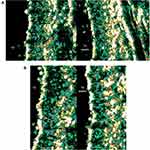Back to Journals » Clinical, Cosmetic and Investigational Dermatology » Volume 15
The Clinical Evidence-Based Paradigm of Topical Anti-Aging Skincare Formulations Enriched with Bio-Active Peptide SA1-III (KP1) as Collagen Modulator: From Bench to Bedside
Authors Rovero P , Malgapo DMH , Sparavigna A , Beilin G, Wong V , Lao MP
Received 14 July 2022
Accepted for publication 14 September 2022
Published 14 December 2022 Volume 2022:15 Pages 2693—2703
DOI https://doi.org/10.2147/CCID.S374295
Checked for plagiarism Yes
Review by Single anonymous peer review
Peer reviewer comments 2
Editor who approved publication: Dr Jeffrey Weinberg
Paolo Rovero,1 Dennis Malvin Hernandez Malgapo,2 Adele Sparavigna,3 Ghislaine Beilin,4 Vincent Wong,5 Ma Purita Lao6
1Department of Neurofarba, Section of Pharmaceutical Sciences and Nutraceutics, University of Florence, Florence, Italy; 2Skinsoul Advanced Dermatology and Medical Aesthetics, Quezon City, Metro Manila, Philippines; 3DERMING S.r.l., Clinical Research and Bioengineering Institute, Milan, Italy; 4Beilin Consultant, Paris, France; 5Vindoc Aesthetics Academy, London, UK; 6Department of Dermatology, Makati Medical Center, Makati City, Metro Manila, Philippines
Correspondence: Dennis Malvin Hernandez Malgapo, Skinsoul Advanced Dermatology and Medical Aesthetics, Spark Place P. Tuazon Blvd, Cubao, Quezon City, Metro Manila, 1109, Philippines, Tel +63 928 6745699, Email [email protected]
Abstract: A substantial reduction in the amount and quality of collagen leads to age-related deterioration of the elasticity and firmness of the skin. In recent years, multiple compounds have been developed aimed at reversing the molecular features of dermal aging. One such target for aging reversal is collagen degradation or turnover. SA1-III is a decapeptide (Ac-Met-Gly-Lys-Val-Val-Asn-Pro-Thr-Gln-Lys-NH2), also known as KP1, formally derived from the C-terminal portion of serpin A1, an agent known as a physiological inhibitor of neutrophil elastase, and has been the subject of laboratory and clinical studies determining its effects on modulation of collagen turnover as well as the treatment of age-associated changes of the face. This review aims to provide a bio-inspired approach focusing on the latest scientific studies that describe the compound, as well as a comprehensive appraisal of laboratory and clinical tests on skincare formulations enriched with sA1-III.
Keywords: KP1, prejuvenation, aging skin, aging well, anti-aging, SA1-III
Corrigendum for this paper has been published.
Introduction
Skin aging is a complex biological process influenced by a combination of endogenous (ie, chrono-aging) and exogenous (ie, from external agents, such as ultraviolet light, environmental insults, etc.) factors.1 One of the most important molecular mechanisms that cause the physical signs of aging is enzymatic degradation of collagen and elastin. This process occurs as a result of the proteolytic enzymes resident in the extracellular matrix (ECM), mainly matrix metalloproteinases (MMPs) and elastase (Figure 1).2
 |
Figure 1 The pathogenesis of premature/extrinsic aging of the skin.2 Reprinted from Kim M, Hyun Jeong, Park. Molecular mechanisms of skin aging and rejuvenation. In: Shiomi H, editor. Molecular Mechanisms of the Aging Process and Rejuvenation. London: IntechOpen; 2016:57–76. © 2016 The Author(s). Licensee IntechOpen. This chapter is distributed under the terms of the Creative Commons Attribution 3.0 License. Abbreviations: ROS, reactive oxygen species; AhR, arylhydrocarbon receptor; NF-kB, nuclear factor kappa‐B; IL, interleukin; TNF-α, tumor necrosis factor; CCN1, cysteine-rich protein 61; MAPK, mitogen‐activated protein kinase; AP‐1, activator protein 1; MMPs, matrix metalloproteinases; ROS, reactive oxygen species; UV, ultraviolet; VEGF, vascular endothelial growth factor. |
Reversal of this process involves targeting oxidation and the aforementioned proteolytic enzymes, now recognized as valuable pharmacological targets for active ingredients in cosmeceuticals and other dermatological products to modulate their action, either directly (inhibitors) or indirectly (down-regulators). Several botanical extracts showing anti-aging properties of cosmeceutical interest possess anti-elastase and/or anti-collagenase activities in vitro.3,4 However, the complexity of these natural ingredients, generally containing a multitude of unidentified chemical components, prevents a rational comprehension of their mode of action at the molecular level. Similarly, bioactive peptides, which are specific protein fragments that are thought to have physiological health benefits, are good candidates for cosmeceutical components that provide enzyme-modulating activity.5 However, they are often available as complex mixtures, derived from botanical extracts and/or protein hydrolysates, thus limiting our ability to obtain scientific evidence of the inherent pharmacological mechanisms leading to the claimed activity.
To varying degrees, synthetic peptides offer the possibility of identifying cosmeceutical active ingredients endowed with a well-defined mechanism of action. While some pharmacological classes, such as signal peptides and neurotransmitter inhibitors, are well represented among the bioactive peptides of cosmeceutical interest, very few enzyme-inhibiting peptides have been described in scientific literature.6
Collagen in Healthy Skin vs Aging Skin
Collagen fibers, found mainly in the dermis and account for 75% dry weight of skin, lend tensile strength and elasticity to the skin.7 As one ages, collagen degrades naturally and this process leads to an alteration in skin form and function and a net deficiency leads to visually apparent changes such as skin wrinkling and loss of firmness and elasticity.7 The main types of collagen involved in skin architecture and physiology are the fibril-forming types, predominantly Types I and III. In adult skin, collagen type III represents no more than 15% of total collagen.8 Recent studies elucidating the mechanisms that impact the production of collagen and its organization into functional fibers have provided new insight into how this bio-scaffold supports living cells and confers the skin its elasticity and firmness.8 A rapidly emerging understanding of the mechanical and structural properties of native collagen fibrils and the ECM has given rise to compounds and devices that may restore collagen and matrix components to their optimal condition.8
SA1-III – a Collagen Turnover Modulating Peptide
In the last two decades, new peptides have been shown to potentially treat certain skin conditions by pharmacologically modulating collagen turnover. Consequently, the spectrum of peptides in the field of cosmetics has continuously expanded.9–11 Although the long‐term benefits of these products have not been fully evaluated, evidence of the benefits derived from their use has steadily grown.12,13
While a couple of peptides have been developed as active cosmeceutical ingredients specifically targeting MMPs, to the best of our knowledge, there is a paucity of clinical data reporting elastase as the target of a specific bioactive peptide in the cosmeceutical arena. Serine protease inhibitor (serpin) A1 (also known as α-1 antitrypsin, α-1 proteinase inhibitor) is a physiological inhibitor of neutrophil elastase, which is involved in the degradation of ECM components. Serpin A1 has therapeutic potential as a wound-healing agent.14 In this review, we implemented a bio-inspired approach toward the description of SA1-III (KP1), a first-in-class bio-active decapeptide (Ac-Met-Gly-Lys-Val-Val-Asn-Pro-Thr-Gln-Lys-NH2) formally derived from the C-terminal portion of serpin A1, using as a starting point a physiological modulator of elastase.15
Materials and Methods
The authors reviewed articles, including both clinical studies and reviews on serpin, published up to 2021. Unpublished data accessible to the authors were also included in the review. Non-relevant articles were excluded based on the title and abstract. Of the remaining articles, the most relevant papers have been reviewed and summarized below.
Results and Discussion
In vitro Evaluation of the Novel Bioactive Peptide SA1-III
One study investigated the in vitro wound-healing action of serpin A1-IGF, a recombinant fusion protein of serpin A1 (M351E-M358L) and insulin-like growth factor, compared with natural serpin A1 or A1-C26, the synthetic C-terminal 26 residue peptide of serpin A1. Using wound models of monolayers of kidney epithelial cell line LLC-PK1 and primary cultures of human skin fibroblasts, the study found that all agents reduced wound sizes.14 The hydrophobic A1-C26 peptide significantly increased the production of collagen I in skin fibroblasts. Furthermore, serpin A1-IGF chimera was associated with a significant increase of cell proliferation and thymidine incorporation in human skin fibroblasts. However, using primary human keratinocytes, wound reduction was only observed with the serpin A1-IGF chimera. These findings demonstrate the wound-healing effects of serpin A1 peptides across various cell lines, which may have favorable skin applications.
A second study described the synthesis and discovery of SA1-III and its impact on collagen production using cultured normal human dermal fibroblasts. The changes in collagen levels were measured in collected culture media using an in-house sandwich enzyme-linked immunosorbent assay technique. The study found that SA1-III was associated with increases in soluble collagen levels in culture media that were similar to those of positive controls, namely L-ascorbic acid and transforming growth factor-beta 1.15 This study demonstrated the collagen-modulating property of SA1-III in vitro.
A third study investigated the mechanisms by which SA1-III increases extracellular collagen levels. In this study, type I collagen was analyzed by means of Western blot in cell lysates and cell-conditioned media of primary human dermal fibroblasts obtained from individuals of different ages. Gelatin zymography was used to investigate the degrading enzymes. The study demonstrated that the SA1-III peptide increased extracellular collagen levels, primarily by reducing degradation while having minimal effect on cellular biosynthesis or cell proliferation.11 Specifically, activity of MMP-2 and MMP-9 were also reduced in cell media upon peptide treatment (Figure 2). No peptide effect was detected on the gene expression of inflammatory mediators in resting and lipopolysaccharide-stimulated fibroblasts. These results suggest that the SA1-III peptide is a good collagen modulator candidate by protecting collagen against degradation without detectable actions on biosynthesis. Furthermore, the study found that SA1-III acted at reasonably low concentrations, did not interfere with cell proliferation, and was effective in primary fibroblasts across individuals from a wide age range.
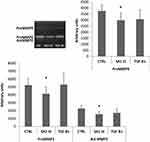 |
Figure 2 Effect of SA1-III (20 mM) peptide and TGF-beta (10 ng/mL) on the secretion and activation of gelatinases MMP-9 (upper right panel) and MMP-2 (lower panel) in culture medium.11 *P<0.05 statistically significant difference (Student’s t-test for paired data) from the corresponding control. Reproduced from Cipriani C, Pascarella S, Errante F, et al. Serpin A1 and the modulation of type I collagen turnover: effect of the C-terminal peptide 409–418 (SA1-III) in human dermal fibroblasts. Cell Biol Int. 2018;42(10):1340–1348. Copyright 2018, John Wiley and Sons. Abbreviations: CTRL, control; MMP, matrix metalloprotease; TGF-B1, transforming growth factor beta-1. |
Available SA1-III (KP1) Formulations
Certain SA1-III (KP1) formulae have been made available in face serum, face cream and eye contour cream (Table 1). Aside from KP1, these formulations include key ingredients that result in a multitude of beneficial effects on the skin and in concert, optimize the skin’s appearance and texture. The face serum, face cream and eye contour cream all contain high-molecular weight and low-molecular weight hyaluronic acid, and creatine. High-molecular weight hyaluronic acid (1800 kDa) hydrates the superficial layers (stratum corneum) but does not penetrate the dermal layer.16 In contrast, low-molecular weight hyaluronic acid (50 kDa) is able to penetrate the skin, where it is able hydrate the deeper skin layers and exerts multiple anti-wrinkle and anti-aging effects by influencing the expression of genes involved in keratinocyte differentiation and formation of intercellular tight junction complexes. Meanwhile, topically applied creatine improves skin wrinkles by stimulating dermal collagen.17
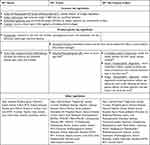 |
Table 1 Ingredients of KP1 Serum, Face Cream and Eye Contour Cream |
The face serum and cream both contain niacinamide, which has been shown to reduce fine lines and wrinkles, hyperpigmented spots, red blotchiness, and skin sallowness (yellowing). In addition, it improves skin elasticity as measured via cutometry.18 The face serum also contains active Tuber magnatum (white truffle) extract, a rare extract used in cosmetic products to increases skin elasticity and hydration (by modulating gene expression in the dermis) and to reduce dark circles and wrinkles.19
The face cream and eye contour cream both contain tocopherol, a fat-soluble antioxidant (free-radical scavenger) with a long history of use in cosmetic products due to its ability to protect the skin from the various deleterious effects of solar radiation.20 The face cream includes the key component salicyloyl-phytosphingosine, a sphingolipid derivative that increases the deposition of fibrillin-1 and procollagen-I and reduces matrix metalloprotease-1 in the basement membrane and papillary dermis, reduces wrinkle depth, and improves skin smoothness in photoaged skin.21 Cross-linked low molecular weight hyaluronic acid hydrates the skin quickly, deeply, and immediately (reduce wrinkles appearance only half an hour after-application).
Finally, the eye contour cream contains sodium hyaluronic acid crosspolymer (cross-linked low-molecular weight hyaluronic acid) and two other bioactive peptides, namely acetyl hexapeptide-3 (ie acetyl hexapeptide-8) and acetyl tetrapeptide-5. Low-molecular weight hyaluronic acid hydrates the skin deeply and rapidly, with a significant reduction of wrinkles being noted after 1 to 2 months of application.22 Acetyl hexapeptide-3 is a neurotransmitter-inhibitor hexapeptide. It inhibits neurotransmitter release with a potency similar to botulinum toxin and is proven effective in short-term reduction of expression lines by interfering with the SNARE complex, a protein complex that is required for calcium-dependent exocytosis.23 Lastly, acetyl tetrapeptide-5 inhibits angiotensin-converting enzyme, which results in a draining and decongestant effect that results in increased hydration and elasticity in the periocular area and a reduction in eye edema and dark circles.24
Clinical Data on Formulations Enriched with SA1-III (KP1)
Instrumental and Subjective Evaluation
The clinical benefits of SA1-III (KP1) formulations, with the concerted effects of their key ingredients, have been evaluated in two instrumental and subjective studies (Table 2). The first study evaluated a KP1 face cream and enrolled 20 female volunteers. Results of this study showed that after 4 weeks of use, a cosmeceutical with the active ingredient of SA1-III had statistically significant improvements in the mean basal values of skin hydration (+43.1%; p<0.0001), in the mean basal values of skin elasticity (skin extensibility: −14.3% and gross elasticity: +5.8%; both p<0.0001), in the mean basal value of skin density (p<0.001), and in the mean basal value of skin roughness (average skin roughness: −13.0% [p<0.01] and average maximum roughness: −10.1% [p<0.001]).25
 |
Table 2 Results of Instrumental and Subjective Evaluations of SA1-III Face Cream and Face Serum |
The second study reported the efficacy of the KP1 serum on 30 volunteers aged 30 to 50 years (mean age of 43.1 years) who were in general good health old. Of these patients, 20% were Phototype V (6 subjects), 26.7% Phototype IV (8 subjects), 30% Phototype III (9 subjects), and 23.3% Phototype I–II (7 subjects). The subjects applied the cosmetic serum on the face twice a day (in the morning and in the evening) for 4 weeks. At the end of the study, skin hydration improved from 52.5 ± 9.6 corneometric units (cu) at baseline to 69.3 ± 11.0 cu at Week 4 (p<0.0001).26 The increase in hydration observed with the serum (32.0%) is numerically lower than with the cream (43.1%), probably due to the lipid component present in the cream but not in the serum.
With the face serum, skin deep hydration increased by 3.3% (p<0.01), skin extensibility decreased by 28.4% (p<0.0001), gross elasticity increased by 8.7% (p<0.0001), skin average roughness by 3D optical profilometry decreased by 13.4% (p<0.001) (Figure 3) and skin density (echogenicity) increased by 2.67% (p<0.0001). Figure 4 shows digital images of skin echogenicity/density obtained by Ultrasound Scanner Dermascan, which shows increased echogenic dermal fibers after 4 weeks of treatment with KP1 face serum and face cream. The
 |
Figure 3 3D skin images obtained by Primos Pico Optical 3D Skin Measuring Device on a heathy volunteer before and after 4 months of treatment with KP1 serum. Courtesy of ISPE S.r.l. |
greater activity of the serum in increasing skin elasticity and density compared with the cream could be due to the active white truffle extract, which stimulates the production of elastin.
Clinical Evaluation Studies
The efficacy and safety of SA1-III formulae demonstrated in the aforementioned Instrumental and subjective evaluations have been confirmed in several clinical evaluation studies.
An open-label, single-center clinical trial evaluating the effects of KP1 face serum demonstrated the efficacy on 20 women aged 40–65 years with normal skin. When used twice daily, KP1 serum treatment was associated with improvement of fine wrinkles (+19%), skin compactness (+14%), brightness/luminosity (+33%) and microrelief regularity (+17%) over treated areas (all p<0.05 vs baseline).27 All parameters were assessed using a 4-point Likert scale except for compactness, which used a 5-point Likert scale. Figure 5 shows photographs of select participants before and after 4 weeks of treatment.
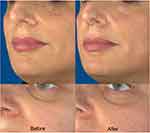 |
Figure 5 Photographs of selected participants before and after 4 weeks of treatment with a KP1 face serum. Courtesy of DERMING, S.r.l. |
A similarly designed open-label, single-center clinical trial evaluating the effects of a face cream with KP1 showed similar efficacy results in 20 healthy female volunteers aged 40 to 65 years. The study found that KP1 face cream was associated with significant improvement in self-assessed fine wrinkles (+11%), tone/elasticity (+12%), and luminosity of the skin (42%) (all p<0.05 vs baseline).28 Figure 6 shows photographs of select participants before and after four weeks of treatment. Of note, there was observed greater moisturizing activity of the facial cream versus the serum due to the activity of its lipid component. On the other hand, the serum was seen to improve elasticity and density at a greater extent than the cream due to the white truffle extract, which stimulates the production of elastin.
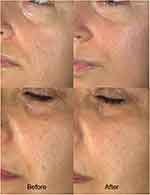 |
Figure 6 Photographs of selected participants before and after 4 weeks of treatment with a KP1 face cream. Courtesy of DERMING, S.r.l. |
Lastly, an open-label, single-center clinical trial evaluated the effects of an eye contour cream with KP1 on 20 healthy female volunteers aged 45 to 60 years. When applied twice daily, the eye contour cream was associated with improvement of dark circles (−10.7% change in bluish or brown pigmentation by colorimetry) and crow’s feet (−19.2% change in average roughness by profilometry) (both p<0.05 vs baseline).29 Furthermore, almost all patients reported improvements in puffiness, deep and superficial wrinkles, and improved skin dryness around the eye, with 55% reporting medium to very marked improvement in dark circles, 62% with medium to very marked improvement in puffiness, and 60% and 63% reporting medium to very marked improvement in deep and superficial wrinkles, respectively.
In all three studies, no adverse effects of the KP1 formulae were reported and all participants rated the formulae as having good or excellent tolerability. Overall, these three clinical studies strongly support the anti-age efficacy and tolerability of the three KP1 formulas.
Future Direction and Applications of SA1-III
We cannot exclude a priori that SA1-III peptide might also protect collagen type III from degradation, either directly or indirectly. This is one of the many aspects that further in vitro studies could clarify. Certain individuals espouse the idea of ‘well-aging’, a new concept of lifestyle, defines an alternative to the conventional anti-aging strategy.30 Millennials, defined as the generation of individuals born between 1981 and 1996, have emerged as one of the leading patient demographics with a growing interest in minimally invasive cosmetic procedures. Worldwide, these groups represent populations that are more likely to consider preventative treatments (ie prejuvenation) compared to any other age group.31 With the increasing popularity of aesthetic treatments and the growing proportion of patients who are millennials, it is important for physicians to understand the current trends, which can offer insights to better forecast patient demand and optimize practice management. Although it has been anecdotally reported that the popularity of cosmetic procedures has increased with millennials, available data on consumer behavior is limited.32
Various combinations of compounds harboring bioactive peptides displaying different modes of action may be used to create a concerted anti-aging effect. More studies are needed to select the most suitable peptides and to evaluate the interactions among these preparations.
Conclusion
Latest advancements in the study of the molecular mechanisms of skin structural changes have provided insights to alternate therapeutic mechanisms for the aging skin. Pharmacological modulation of collagen turnover appears to be a viable strategy in remedying wrinkling and the loss of skin elasticity. Among the collagen modulators that have recently garnered attention are derivatives of the serine protease inhibitor serpin A1 and portions of its C-terminal region, in particular SA1-III. This review highlights currently available evidence, including clinical evaluation studies, showing the bio-active properties of SA1-III as it relates to wound healing, modulation of collagen turnover, as well as the efficacy of its cosmeceutical formulae (ie, KP1 formula) in addressing wrinkles, loss of skin integrity, dullness, irregularities, and dark eye circles and puffiness.
Acknowledgments
We thank RELIFE S.r.l. for providing an unrestricted educational grant for this review.
Disclosure
Dr Dennis Malvin Hernandez Malgapo reports grants from RELIFE S.r.l., during the conduct of the study. Dr Ghislaine Beilin reports personal fees, non-financial support from BIOXIS, non-financial support from REGENT LAB, grants from CEBELIA, personal fees from CROMA, outside the submitted work. The authors report no conflicts of interest in this work.
References
1. Ganceviciene R, Liakou AI, Theodoridis A, Makrantonaki E, Zouboulis CC. Skin anti-aging strategies. Dermato-Endocrinology. 2012;4(3):308–319. doi:10.4161/derm.22804
2. Kim M, Hyun Jeong, Park. Molecular mechanisms of skin aging and rejuvenation. In: Shiomi H, editor. Molecular Mechanisms of the Aging Process and Rejuvenation. London: IntechOpen; 2016:57–76.
3. Jiratchayamaethasakul C, Ding Y, Hwang O, et al. In vitro screening of elastase, collagenase, hyaluronidase, and tyrosinase inhibitory and antioxidant activities of 22 halophyte plant extracts for novel cosmeceuticals. Fish Aquatic Sci. 2020;23(1):1–9. doi:10.1186/s41240-020-00149-8
4. Zofia NŁ, Martyna ZD, Aleksandra Z, Tomasz B. Comparison of the antiaging and protective properties of plants from the Apiaceae family. Oxi Med Cell Longev. 2020;2020. doi:10.1155/2020/5307614
5. Aguilar-Toalá JE, Hernández-Mendoza A, González-Córdova AF, Vallejo-Cordoba B, Liceaga AM. Potential role of natural bioactive peptides for development of cosmeceutical skin products. Peptides. 2019;122:170170. doi:10.1016/j.peptides.2019.170170
6. Ferreira MS, Catarina M, Sousa-lobo JM, Almeida IF. Trending anti-aging peptides. Cosmetics. 2020;7(91):1–15. doi:10.3390/cosmetics7040091
7. Shin JW, Kwon SH, Choi JY, et al. Molecular mechanisms of dermal aging and antiaging approaches. Int J Mol Sci. 2019;20(9):1. doi:10.3390/ijms20092126
8. Reilly DM, Lozano J. Skin collagen through the lifestages: importance for skin health and beauty. Plast Aesthet Res. 2021;2021:5. doi:10.20517/2347-9264.2020.153
9. Schagen SK. Topical peptide treatments with effective anti-aging results. Cosmetics. 2017;4(2):2. doi:10.3390/cosmetics4020016
10. Errante F, Ledwoń P, Latajka R, Rovero P, Papini AM. Cosmeceutical peptides in the framework of sustainable wellness economy. Front Chem. 2020;8:1–8. doi:10.3389/fchem.2020.572923
11. Cipriani C, Pascarella S, Errante F, et al. Serpin A1 and the modulation of type I collagen turnover: effect of the C-terminal peptide 409–418 (SA1-III) in human dermal fibroblasts. Cell Biol Int. 2018;42(10):1340–1348. doi:10.1002/cbin.11018
12. Husein El Hadmed H, Castillo RF. Cosmeceuticals: peptides, proteins, and growth factors. J Cosmet Dermatol. 2016;15(4):514–519. doi:10.1111/jocd.12229
13. Ledwoń P, Errante F, Papini AM, Rovero P, Latajka R. Peptides as active ingredients: a challenge for cosmeceutical industry. Chem Biodivers. 2021;18(2):e2000833. doi:10.1002/cbdv.202000833
14. Congote LF, Temmel N, Sadvakassova G, Dobocan MC. Comparison of the effects of serpin A1, a recombinant serpin A1-IGF chimera and serpin A1 C-terminal peptide on wound healing. Peptides. 2008;29(1):39–46. doi:10.1016/j.peptides.2007.10.011
15. Pascarella S, Tiberi C, Sabatino G, et al. Serpin A1 C-terminal peptides as collagen turnover modulators. ChemMedChem. 2016;11(16):1850–1855. doi:10.1002/cmdc.201500472
16. Essendoubi M, Gobinet C, Reynaud R, Angiboust JF, Manfait M, Piot O. Human skin penetration of hyaluronic acid of different molecular weights as probed by Raman spectroscopy. Skin Res Technol. 2015;22(1):55–62. doi:10.1111/srt.12228
17. Fischer F, Achterberg V, März A, et al. Folic acid and creatine improve the firmness of human skin in vivo. J Cosmet Dermatol. 2011;10(1):15–23. doi:10.1111/j.1473-2165.2010.00543.x
18. Bissett DL, Oblong JE, Berge CA. Niacinamide: a B vitamin that improves aging facial skin appearance. Dermatol Surg. 2006;31:860–866. doi:10.1111/j.1524-4725.2005.31732
19. White Truffle. W TR-active multiple anti-aging effects through epigenetic modulation. Available from: https://www.phenbiox.it/w-tr-active/s8edb56f3.
20. Keen MA, Hassan I. Vitamin E in dermatology. Indian Dermatol Online J. 2016;7(4):311–315. doi:10.4103/2229-5178.185494
21. Farwick M, Watson REB, Rawlings AV, et al. Salicyloyl-phytosphingosine: a novel agent for the repair of photoaged skin. Int J Cosmet Sci. 2007;29(4):319–329. doi:10.1111/j.1467-2494.2007.00394.x
22. Pavicic T, Gauglitz GG, Lersch PDR, et al. Efficacy of cream-based novel formulations of hyaluronic acid of different molecular weights in anti-wrinkle treatment. J Drugs Dermatol. 2011;10(9):990–1000.
23. Blanes-Mira C, Clemente J, Jodas G, et al. A synthetic hexapeptide (Argireline) with antiwrinkle activity. Int J Cosmet Sci. 2002;24(5):303–310. doi:10.1046/j.1467-2494.2002.00153.x
24. Pai V, Bhandari P, Shukla P. Topical peptides as cosmeceuticals. Indian J Dermat Venereol Leprol. 2017;83(1):9. doi:10.4103/0378-6323.186500
25. ISPE. Instrumental and subjective evaluation of the anti-age efficacy of a cosmetic product. Report 142/18/01 [report]; 2018.
26. ISPE. Instrumental and subjective evaluation of the anti-age efficacy of a cosmetic product. Report 196/21/01_rev1 [report]; 2022.
27. DERMING S.r.l. Anti-age efficacy and tolerance evaluation of a face serum. Test code: E0121 [report]; 2021.
28. DERMING S.r.l. Anti-age efficacy and tolerance evaluation of a face cream. Test code: E0221 [report]; 2021.
29. DERMING S.r.l. Clinical study for the tolerability and anti-age efficacy of an eye-contour treatment. Test code: E0321 [report]; 2021.
30. De Tollenaere M, Meunier M, Scandolera A, et al. Well-aging: a new strategy for skin homeostasis under multi-stressed conditions. J Cosmet Dermatol. 2020;19(2):444–455. doi:10.1111/jocd.13047
31. Mobayed N, Nguyen JK, Jagdeo J. Minimally invasive facial cosmetic procedures for the millennial aesthetic patient. J Drugs Dermatol. 2020;19(1):100–103. doi:10.36849/JDD.2020.4641
32. Wang JV, Akintilo L, Geronemus RG. Growth of cosmetic procedures in millennials: a 4.5-year clinical review. J Cosmet Dermatol. 2020;19(12):3210–3212. doi:10.1111/jocd.13768
33. Sundaram H, Cegielska A, Wojciechowska A, Delobel P. Prospective, randomized, investigator-blinded, split-face evaluation of a topical crosslinked hyaluronic acid serum for post-procedural improvement of skin quality and biomechanical attributes. J Drugs Dermatol. 2018;17(4):442–450.
 © 2022 The Author(s). This work is published and licensed by Dove Medical Press Limited. The full terms of this license are available at https://www.dovepress.com/terms.php and incorporate the Creative Commons Attribution - Non Commercial (unported, v3.0) License.
By accessing the work you hereby accept the Terms. Non-commercial uses of the work are permitted without any further permission from Dove Medical Press Limited, provided the work is properly attributed. For permission for commercial use of this work, please see paragraphs 4.2 and 5 of our Terms.
© 2022 The Author(s). This work is published and licensed by Dove Medical Press Limited. The full terms of this license are available at https://www.dovepress.com/terms.php and incorporate the Creative Commons Attribution - Non Commercial (unported, v3.0) License.
By accessing the work you hereby accept the Terms. Non-commercial uses of the work are permitted without any further permission from Dove Medical Press Limited, provided the work is properly attributed. For permission for commercial use of this work, please see paragraphs 4.2 and 5 of our Terms.

